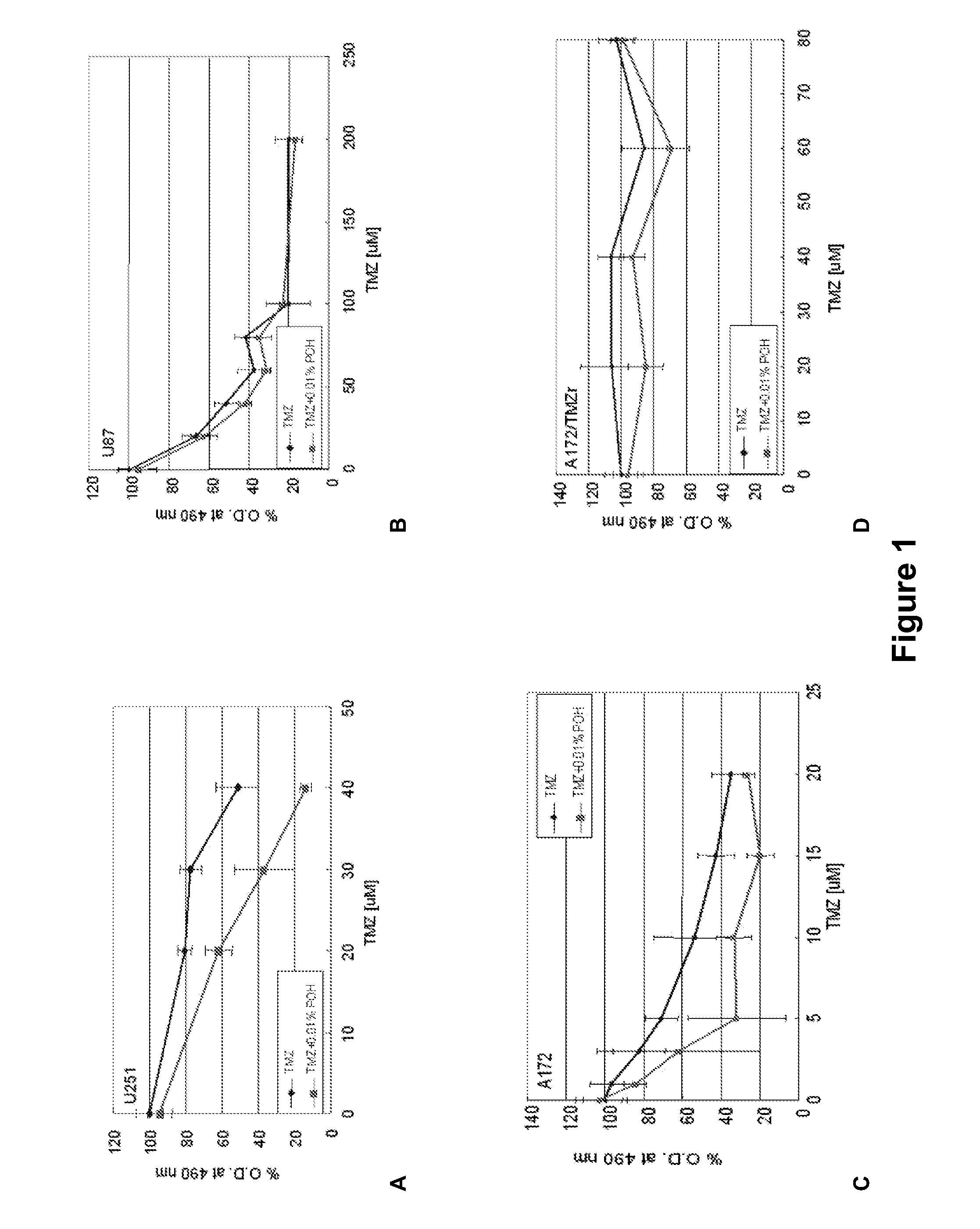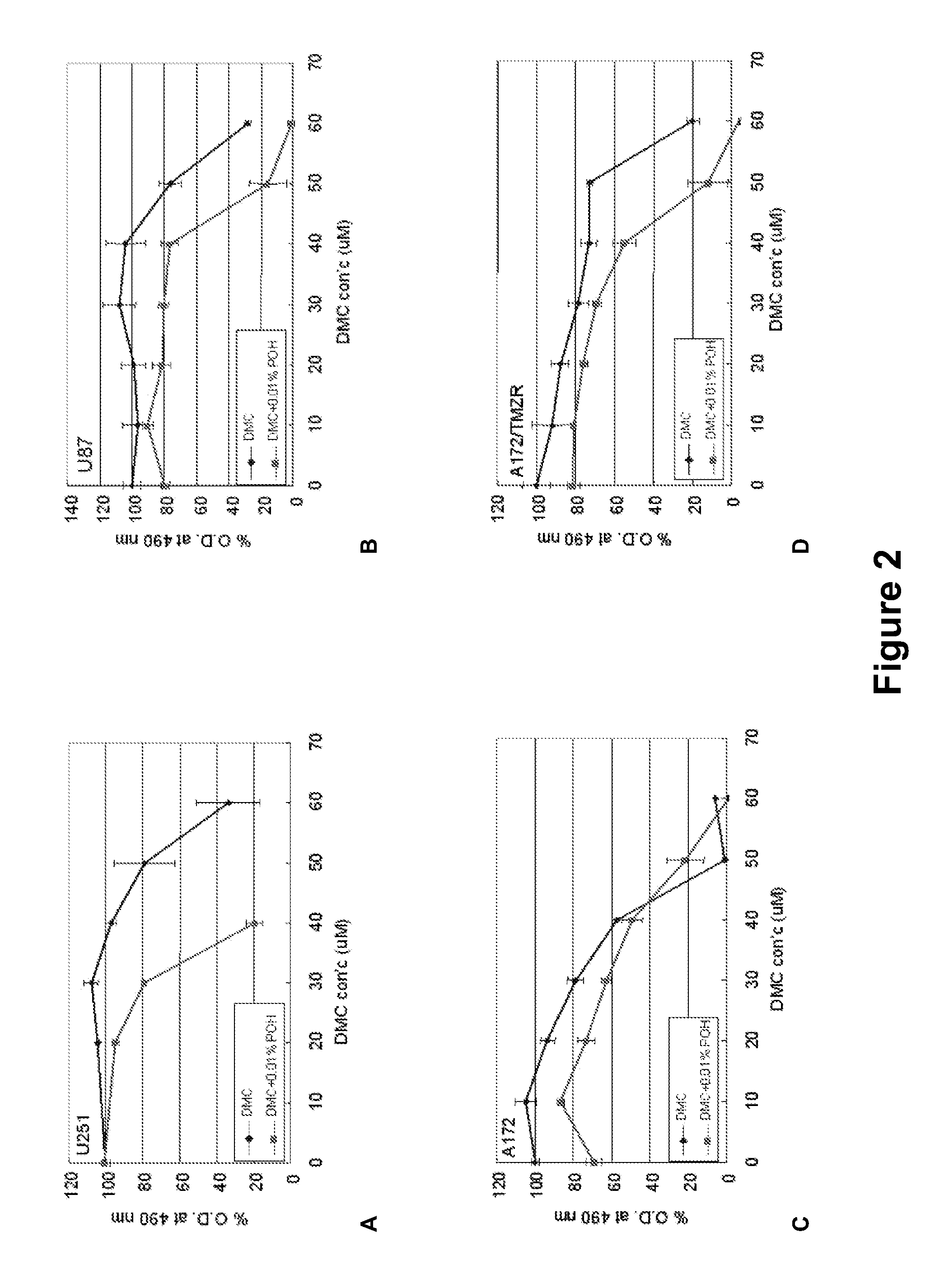Therapeutic Compositions Comprising Monoterpenes
a technology of monoterpenes and compositions, applied in the direction of antibody medical ingredients, spray delivery, aerosol delivery, etc., can solve the problems of poor prognosis, intractable, and difficult to deliver these drugs to brain tumors, and achieve the effect of enhancing the activity of therapeutic agents
- Summary
- Abstract
- Description
- Claims
- Application Information
AI Technical Summary
Benefits of technology
Problems solved by technology
Method used
Image
Examples
experiment # 1
Experiment #1—In Vitro Efficacy
[0124]Current brain tumors are treated with intravenous or oral chemotherapy. Because the blood brain barrier prevents adequate delivery of conventional chemotherapy via these two routes, brain cancer is still largely untreatable. POH is delivered via nasal inhalation to the brain tumor. It has been demonstrated to be safely tolerated in patients, and to induce radiographic reduction in tumor size in patients with malignant gliomas. The mechanism of delivery is felt to be via the olfactory tract and systemically via the nasal vasculature.
[0125]The mechanism of POH action is thought to be via suppression of small G proteins synthesis, including Ras. In addition to malignant gliomas, POH has been demonstrated to be effective against a number of systemic malignancies including breast, lung, pancreatic, melanomas. It is currently administered via a nasal inhaler four times daily, and has been found to be well tolerated, with minimal side effects.
[0126]POH ...
experiment # 2
Experiment #2—Cell Culture
[0128]Human malignant gliomas U-87 and A-172 cells, can be obtained from the American Type Culture Collection (ATCC). Explanted specimen (GBM-1) can be obtained from a patient with glioblastoma multiforme using standard surgical procedures. Cells are grown as monolayers in 25 cm2 tissue culture flasks in Dulbecco's modified Eagle medium supplemented with 0.2 mM non-essential amino acids, 10% fetal calf serum, penicillin (100 U / ml), streptomycin (100 μm / ml) and amphotericin B (fungizone, 2.5 mg / ml). For subcultures, cells are washed with phosphate-buffered saline (PBS, pH 7.2), detached by short exposure to trypsin and suspended in culture medium.
experiment # 3
Experiment #3—Cell Viability Assay
[0129]Cells (104 / ml) are cultivated in 96-well tissue culture plates for 24 h at 37° C., 5% CO2. Cultures are then treated with DMEM or different concentrations of the composition (Sigma, St. Louis, Mo., USA). After 48 h, cells are treated with MTT (5 mg / ml), incubated for at least 4 h in the dark, and the formazan crystals are subsequently solubilized in 200 μl DMSO. The extension of reduction of MTT can be quantified by 570 nm absorbance measurement with a 630 nm reference filter.
PUM
| Property | Measurement | Unit |
|---|---|---|
| v/v | aaaaa | aaaaa |
| v/v | aaaaa | aaaaa |
| size | aaaaa | aaaaa |
Abstract
Description
Claims
Application Information
 Login to View More
Login to View More - R&D
- Intellectual Property
- Life Sciences
- Materials
- Tech Scout
- Unparalleled Data Quality
- Higher Quality Content
- 60% Fewer Hallucinations
Browse by: Latest US Patents, China's latest patents, Technical Efficacy Thesaurus, Application Domain, Technology Topic, Popular Technical Reports.
© 2025 PatSnap. All rights reserved.Legal|Privacy policy|Modern Slavery Act Transparency Statement|Sitemap|About US| Contact US: help@patsnap.com


